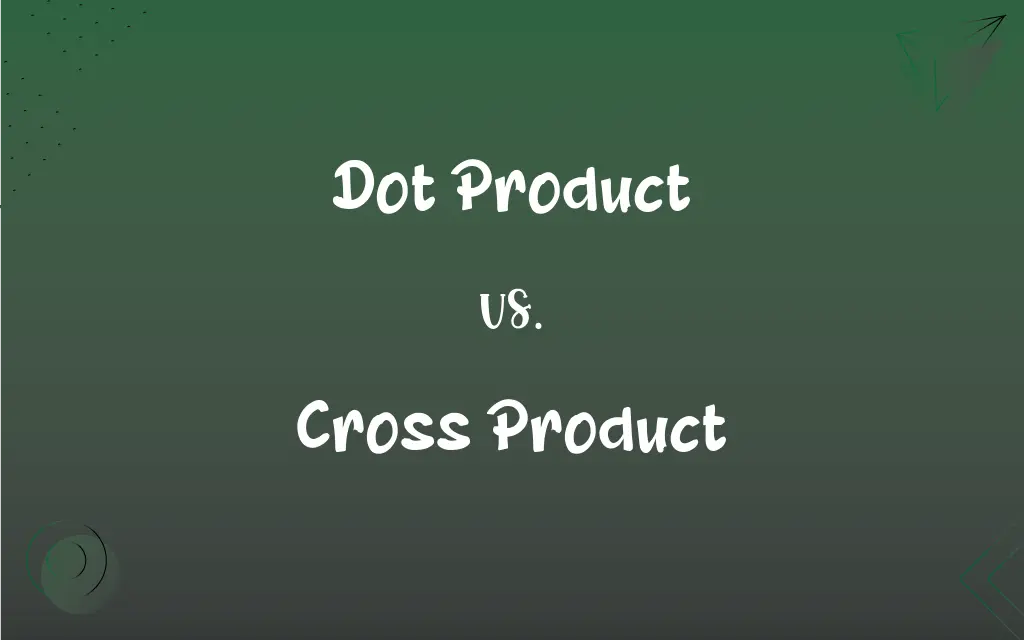Dot Product vs. Cross Product: What's the Difference?
Edited by Aimie Carlson || By Harlon Moss || Updated on October 5, 2023
Dot product results in a scalar and is commutative; cross product results in a vector and is anti-commutative.

Key Differences
The dot product, also known as the scalar product, merges two vectors into a scalar quantity, encapsulating the idea that it involves the projection of one vector onto another. Mathematically, it’s defined as the product of the magnitudes of the two vectors and the cosine of the angle between them. The dot product is immensely applicable in projecting vectors, understanding work done, and determining the angle between vectors in physics and engineering, hence its ubiquity in these disciplines.
The cross product, or the vector product, contrasts by producing a vector as a result. Its magnitude is equal to the product of the magnitudes of the two vectors and the sine of the angle between them, while its direction is orthogonal to the plane formed by the two vectors, adhering to the right-hand rule. The cross product is paramount in understanding rotational mechanics and is pivotal in determining the torque exerted about a point.
While the dot product produces a scalar, conferring information regarding the length or magnitude related to the input vectors, the cross product yields a vector, revealing something about the orientation of the original vectors in a spatial context. The former is often used when determining work done or projecting vectors, whereas the latter frequently finds use in understanding rotational effects and phenomena in physical systems.
The algebraic procedures to find the dot and cross products are inherently different. The dot product calculates by multiplying corresponding components and summing them, whereas the cross product computes by finding the determinant of a matrix constituted by unit vectors and the vectors being multiplied. These distinct processes are chosen based on their suitability to unravel particular physical or geometric inquiries.
In the realm of vector spaces and geometric interpretations, the dot product and cross product serve to uncover diverse aspects of the vectors involved. While the dot product can expose the angle between two vectors, the cross product can help establish a vector perpendicular to the plane of two other vectors. Therefore, each product plays a distinct role in providing insights into the geometric and spatial properties of vectors.
ADVERTISEMENT
Comparison Chart
Result Type
Scalar
Vector
Dimensionality
Defined in any dimension
Defined only in three dimensions
Physical Relevance
Work, projection
Torque, rotational phenomena
Dot Product and Cross Product Definitions
Dot Product
The dot product quantifies the similarity between two vectors, producing a scalar.
In machine learning, the dot product helps calculate the cosine similarity between vectors.
Cross Product
The cross product can be calculated using a determinant of a special matrix comprising the unit vectors and the input vectors.
In mathematics, the cross product supports solving problems related to volumes of parallelepipeds.
ADVERTISEMENT
Dot Product
It combines two vectors to produce a scalar by multiplying their magnitudes and the cosine of the angle between them.
The dot product is used to find the angle between two vectors when rearranging the dot product formula.
Cross Product
It multiplies the magnitudes of two vectors and the sine of the angle between them, directing according to the right-hand rule.
Mechanical engineers utilize the cross product to determine torque in rotational systems.
Dot Product
It is commutative, meaning changing the order of the vectors doesn’t change the result.
In mathematics, the dot product is used understanding vector spaces due to its commutative property.
Cross Product
It is defined only in three-dimensional space, leveraging its spatial interpretation.
In vector calculus, the cross product assists in defining the curl of a vector field.
Dot Product
It reveals the length projected of one vector onto another.
Engineers use the dot product to ascertain vector projections in structural analysis.
Cross Product
The cross product results in a vector perpendicular to the plane formed by the two input vectors.
In electromagnetism, the cross product aids in defining the direction of the magnetic field.
Dot Product
The dot product is the sum of the products of corresponding entries of two sequences of numbers.
In physics, the dot product is employed to compute work done by a force.
Cross Product
The cross product is anti-commutative, implying that reversing the order of vectors negates the result.
The cross product is applied in computer graphics to determine the normal of a plane.
FAQs
Is the cross product applicable in all dimensional spaces?
No, the cross product is defined only in three-dimensional space.
How is the direction of the cross product determined?
The direction of the cross product is determined using the right-hand rule.
What does the dot product yield?
The dot product yields a scalar.
How does commutativity apply to the cross product?
The cross product is anti-commutative: a×b = -b×a.
How does the dot product relate to cosine?
The dot product involves the cosine of the angle between two vectors in its computation.
Can the cross product be used to find the area of a parallelogram?
Yes, the magnitude of the cross product gives the area of the parallelogram formed by two vectors.
What is the output of a cross product?
The cross product produces a vector.
Can dot and cross products be applied to non-physical quantities?
Yes, dot and cross products can be utilized in various fields, like computer graphics or machine learning.
Which mathematical operation is used in the calculation of the cross product?
The cross product is calculated using the determinant of a specific matrix.
What is the physical significance of the dot product?
The dot product is often related to work done by a force or vector projection.
How is the cross product used in physics?
The cross product is used to determine phenomena like torque and angular momentum in physics.
In which spaces is the dot product defined?
The dot product is defined in any dimensional space.
Can dot and cross products be applied to vectors in four-dimensional space?
The dot product can, but the cross product is specific to three-dimensional space.
What information can be gleaned from a zero cross product?
A zero cross product indicates that the two vectors are parallel.
Are there generalizations of the cross product to other dimensions?
There are generalized versions, such as the seven-dimensional cross product, but they are not as commonly used as the three-dimensional one.
Is the dot product commutative?
Yes, the dot product is commutative: a·b = b·a.
Is sine function involved in dot product calculation?
No, the dot product utilizes the cosine function, not sine.
How are dot and cross products utilized in computer graphics?
They're used to calculate angles between vectors (dot product) and normals to surfaces (cross product).
What is the geometric implication of a zero dot product?
A zero dot product implies that the two vectors are perpendicular to each other.
How do dot and cross products relate to vector lengths?
The dot product relates to the cosine of the angle between vectors, and the cross product to the sine, both involving vector lengths in their calculations.
About Author
Written by
Harlon MossHarlon is a seasoned quality moderator and accomplished content writer for Difference Wiki. An alumnus of the prestigious University of California, he earned his degree in Computer Science. Leveraging his academic background, Harlon brings a meticulous and informed perspective to his work, ensuring content accuracy and excellence.
Edited by
Aimie CarlsonAimie Carlson, holding a master's degree in English literature, is a fervent English language enthusiast. She lends her writing talents to Difference Wiki, a prominent website that specializes in comparisons, offering readers insightful analyses that both captivate and inform.
































































